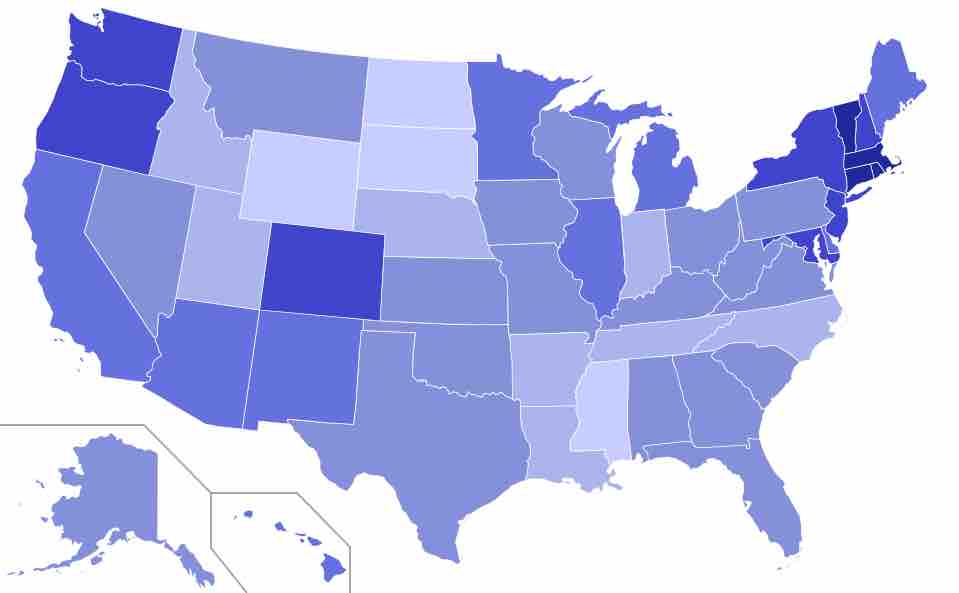Voting Based on Ideology
Sometimes, people vote based on their political ideology. The ideological position a person or party takes may be described in terms of what kinds of social and economic policies they would like to see implemented. Political ideologies in the United States vary considerably. Persons in the U.S. generally classify themselves either as adhering to positions along the political spectrum as liberal-progressive, moderate, or conservative, but there are several subgroups of all of these three. Among those who do identify as either liberal or conservative, few identify as "far left" or "far right. " Most Americans either identify as "moderate" or as "somewhat" liberal or conservative.
Conservatives and Liberals
Modern American liberalism aims at the preservation and extension of human, social and civil rights as well as the government guaranteed provision of positive rights. American conservatism commonly refers to a combination of economic liberalism and social conservatism and to an extent, libertarianism. It aims at protecting traditional values (especially on social issues) while promoting the concept of small government.
In the U.S., the Democratic Party generally represents liberal ideals, while the Republican Party commonly represents conservative ideals. The size of ideological groups varies slightly depending on the poll. Gallup/USA Today polling in June 2010 revealed that 42% of those surveyed identify as conservative, 35% as moderate, while 20% identify as liberal . In another polling in June 2010, 40% of American voters identify themselves as conservatives, 36% as moderates and 22% as liberals, with a strong majority of both liberals and conservatives describing themselves as closer to the center than to the extremes .

Percentage of LIberals in the US
Percent of self-identified liberals in the United States, broken down by state, according to Gallup, August 2010. The darkest colors to lightest colors, respectively, indicate the greatest percentages of people identifying as liberals. (The darkest color represents 28% and above, while the lightest color is under 14%).

Political Ideology Trends
This chart, using Gallup Poll data, depicts trends in US political ideologies from 1992-2012.
Liberalism and conservatism are the most common ideologies in the U.S., apart from those who identify as moderate. Individuals embrace each ideology to widely varying extents. Liberals and progressives commonly advocate strong civil liberties, social progressivism, cultural pluralism, government ensuring of positive rights (education, health care, etc.) and a mixed economy. Conservatives commonly defend the notional status quo of some point in the past, believing that the US has deviated significantly from it, and advocate more traditional stands on social issues, protection of gun rights and much less government intervention.
Moderates
Moderates, who may be left or right leaning, incorporate different aspects from liberalism and conservatism into their personal perspective. According to recent polls, moderates are commonly identified as the second largest group, closely trailing conservatives, constituting between 36% and 39% of the population. Moderates are commonly defined through limiting the extent to which they adopt liberal and conservative ideas. CNN exit polls have found moderates to be rather evenly divided between the country's two main parties. Even though liberals as a whole tend to be the most educated ideological demographic (as indicated by Pew research), moderates tend to become increasingly conservative with increased economic prosperity, causing the professional class to be split between Republicans and Democrats.
Libertarians
While often not mentioned in major polls and less organized than liberal or conservatives, libertarians are a significant minority, constituting roughly 13% of the electorate. Libertarians commonly hold liberal views on social issues but conservative views on economic issues. Since the 1980s, a majority of libertarians have favored the Republican Party, although in recent years, the margin favoring the Republicans has begun to shrink because of the libertarians' opposition to many recent Republican supported social issues.
Typological Groups
In a 2005 study, the Pew Research Center identified nine typological groups. Three groups were identified as part of "the left," "the middle," and "the right. " In this categorization system, "the right" roughly represents the Republican base, those on "the left" the Democratic base and those in "the middle" independents. Within the left are the largely secular and anti-war "Liberals", the socially conservative but economically left "Conservative Democrats", and the economically "Disadvantaged Democrats" who favor extended government assistance to the needy. In "the middle" are the optimistic and upwardly mobile "Upbeats", the discouraged and mistrusting "Disaffecteds," and the disenfranchised "Bystanders. " The right compromises the highly pro-business "Enterprisers," the highly religious "Social Conservatives" (also known as the Christian right), and the "Pro-Government Conservatives" who are largely conservative on social issues but support government intervention to better their economic disposition.